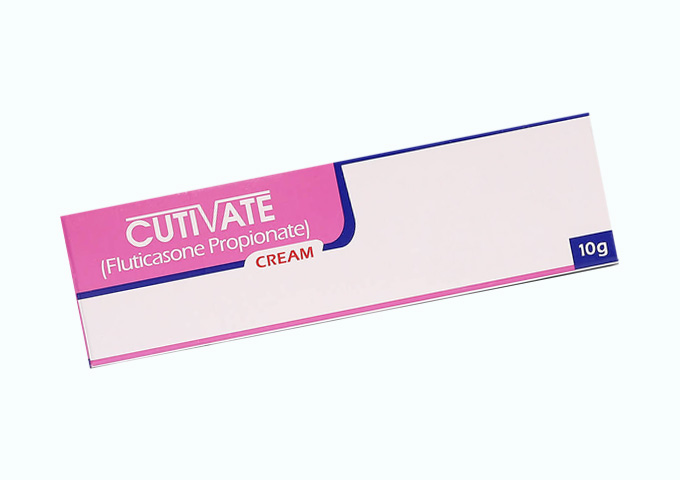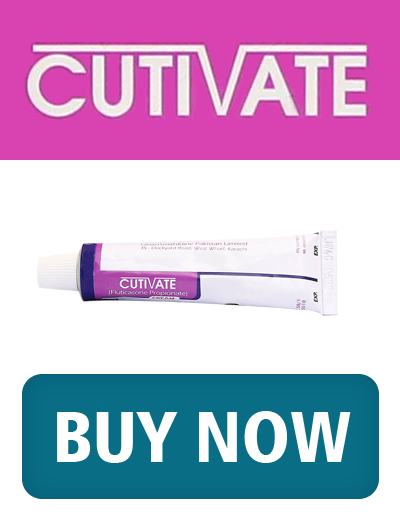Cutivate (Fluticasone Propionate)
Cutivate is a brand name for a medication called fluticasone propionate cream, which belongs to a group of drugs known as corticosteroids. Fluticasone propionate is a synthetic corticosteroid that is used topically (applied to the skin) to help reduce inflammation, itching, redness, and swelling associated with various skin conditions.
The cream is commonly prescribed to treat a variety of skin conditions, such as eczema (atopic dermatitis), psoriasis, contact dermatitis, and other types of allergic or inflammatory skin reactions.
Uses
As mentioned earlier, Cutivate is a topical corticosteroid used to treat various skin conditions. Its primary uses include:
- Eczema (Atopic Dermatitis): Cutivate can help relieve itching, redness, inflammation, and dryness associated with atopic dermatitis, a common form of eczema.
- Psoriasis: It is used to manage mild to moderate plaque psoriasis, a chronic autoimmune skin condition characterized by thick, red, and scaly patches on the skin.
- Contact Dermatitis: Cutivate can be prescribed for contact dermatitis, which occurs when the skin comes into contact with an irritant or allergen, causing redness, itching, and inflammation.
- Allergic Skin Reactions: It is also used to reduce inflammation and itching caused by various allergic skin reactions.
- Other Inflammatory Skin Conditions: Cutivate may be used for other inflammatory skin conditions.
It's crucial to note that Cutivate is for external use only and should not be used on the face.

Dosage
The dosage of Cutivate can vary depending on the specific skin condition being treated and the severity of the symptoms. The general dosing guidelines for Cutivate are as follows:
For Eczema (Atopic Dermatitis) and Psoriasis:
- Apply a thin film of Cutivate to the affected skin areas once daily.
- The cream should be gently rubbed into the skin until it is absorbed.
- Treatment should generally not exceed two weeks.
For Contact Dermatitis and Allergic Skin Reactions:
- Apply a thin film of Cutivate to the affected skin areas once or twice daily.
- The duration of treatment may vary depending on the severity of the condition.
Remember to apply Cutivate only to the affected areas and avoid contact with the eyes, mouth, and other mucous membranes. Wash your hands thoroughly after applying the cream, unless the hands are the area being treated.
It's essential to use the medication exactly as prescribed and not to use more than the recommended amount.
Overdose
Topical corticosteroids like Cutivate are generally safe when used as directed and for the recommended duration. However, an overdose can occur if the cream is used excessively or over a prolonged period, leading to potential side effects. The risk of overdose is higher when large amounts of the cream are applied to a large area of the skin or when it is used more frequently than prescribed.
Symptoms of an overdose of topical corticosteroids may include:
- Thinning of the skin
- Skin discoloration
- Increased vulnerability to skin infections
- Stretch marks
- Easy bruising
- Delayed wound healing
- Changes in hair growth
- Allergic reactions
If you suspect an overdose or experience any unusual or severe side effects after using Cutivate, seek medical attention immediately. It's essential to follow the prescribed dosage and treatment duration to minimize the risk of adverse effects.
Precautions
When using Cutivate or any other topical corticosteroid, it's essential to take certain precautions to ensure safe and effective use. Here are some precautions to consider:
- Follow the Prescribed Dosage: Avoid using more than the recommended amount or for a longer duration than advised, as it may increase the risk of side effects.
- Avoid Sensitive Areas: Do not apply Cutivate to the face, groin, or underarms. These areas are more sensitive, and corticosteroids may cause adverse reactions.
- Avoid Contact with Eyes and Mucous Membranes: Keep the cream away from your eyes, mouth, and other mucous membranes. If accidental contact occurs, rinse thoroughly with water.
- Patch Test: If you are using Cutivate for the first time or have sensitive skin, perform a small patch test before applying the cream to a larger area. This helps ensure you don't have an allergic reaction to the medication.
- Avoid Abrupt Discontinuation: If you've been using Cutivate for an extended period, do not suddenly stop using it. Abruptly discontinuing topical corticosteroids can lead to a rebound effect and worsen your skin condition.
- Monitor for Side Effects: Keep an eye out for any unusual or severe side effects, such as skin thinning, skin discoloration, or allergic reactions. If you experience any concerning symptoms, seek medical attention promptly.
- Pediatric Use: Children may absorb topical corticosteroids more readily through their skin, increasing the risk of side effects.
- Pregnancy and Breastfeeding: If you are pregnant, planning to become pregnant, or breastfeeding, consult your doctor before using Cutivate. The medication's safety during pregnancy and breastfeeding needs to be carefully considered.
- Avoid Use on Infected Skin: Do not use Cutivate on areas with active infections, such as bacterial, viral, or fungal infections. Topical corticosteroids can mask the symptoms of an infection and potentially worsen it.
Side Effects
Like all medications, Cutivate can cause side effects, although not everyone experiences them. Common side effects are generally mild and may include:
- Skin irritation: This can manifest as burning, stinging, itching, or redness at the application site.
- Skin thinning: With prolonged use or overuse, topical corticosteroids like Cutivate can cause thinning of the skin, making it more susceptible to injury.
- Skin discoloration: Prolonged use of Cutivate may lead to changes in skin pigmentation, resulting in darkening or lightening of the treated skin area.
- Stretch marks: Some individuals may develop stretch marks (striae) on the skin with long-term use of topical corticosteroids.
- Increased hair growth: In rare cases, excessive hair growth (hypertrichosis) may occur at the application site.
- Acne: The use of corticosteroids on the face can sometimes lead to the development of acne or worsen pre-existing acne.
- Allergic reactions: Although rare, some people may experience an allergic reaction to the medication, characterized by hives, rash, itching, or swelling.
- Delayed wound healing: Topical corticosteroids may slow down the healing process of wounds or sores.
It's essential to discontinue using Cutivate and seek medical attention if you experience severe side effects or signs of an allergic reaction, such as difficulty breathing, swelling of the face, lips, tongue, or throat, or severe skin rash.
It's important to follow the prescribed usage and dosage of Cutivate and avoid using it for extended periods without medical supervision. Prolonged use of topical corticosteroids can increase the risk of side effects.
Storage
Proper storage of medications is essential to maintain their effectiveness and ensure they remain safe to use. Here are some general guidelines for storing:
- Store at Room Temperature: Keep Cutivate at room temperature, typically between 20°C to 25°C (68°F to 77°F). Avoid exposing the cream to extreme heat or cold, as this may affect its stability.
- Keep Away from Moisture: Protect the cream from moisture by keeping it in its original tightly closed container. Avoid storing it in the bathroom, where humidity levels can be higher.
- Keep Out of Reach of Children: Store the medication in a secure place out of the reach of children and pets.
- Check Expiry Date: Always check the expiration date on the package before using Cutivate. Do not use the cream if it has expired, as it may not be effective or safe.
- Do Not Transfer to Another Container: Keep the cream in its original container to ensure that it remains properly labeled and identified.
- Avoid Freezing: Do not freeze Cutivate. Freezing may alter the consistency and effectiveness of the cream.
- Check for Discoloration or Changes: Before using Cutivate, inspect the cream for any changes in color, consistency, or odor. If you notice any abnormalities, do not use the medication.
- Dispose Properly: If you have unused or expired Cutivate, follow appropriate disposal guidelines recommended by your local waste management authorities or pharmacist.
Always follow the storage instructions provided with the medication, and if you have any specific questions or concerns about storing Cutivate, consult your pharmacist for further guidance. Proper storage helps ensure that the medication retains its potency and is safe for use when needed.
